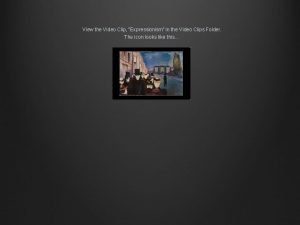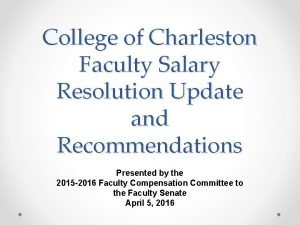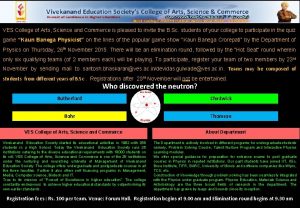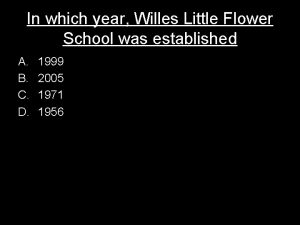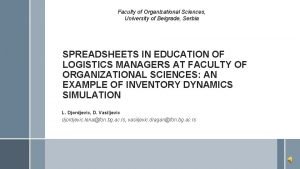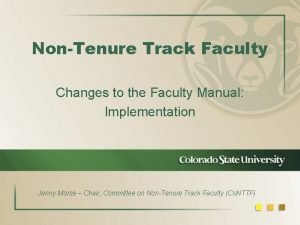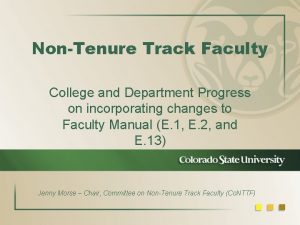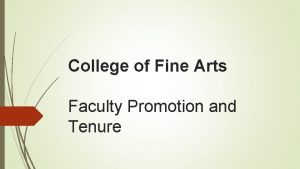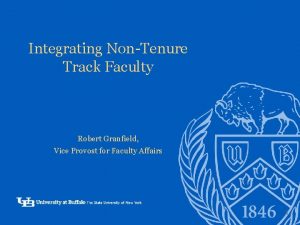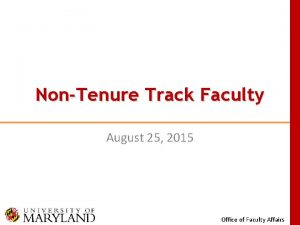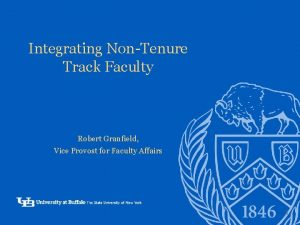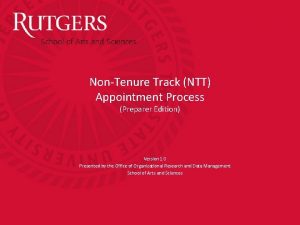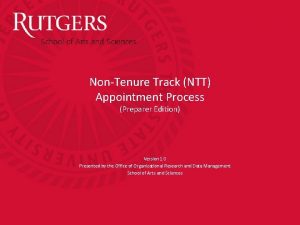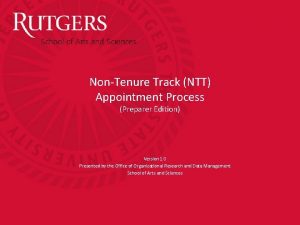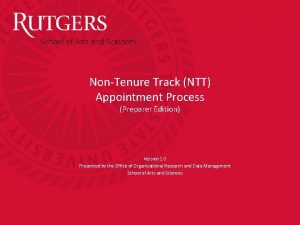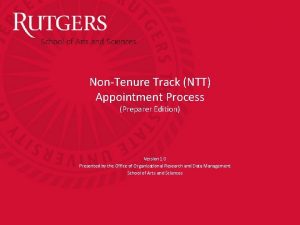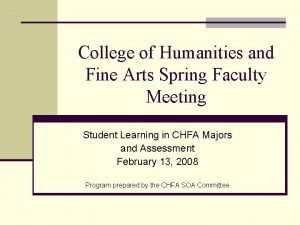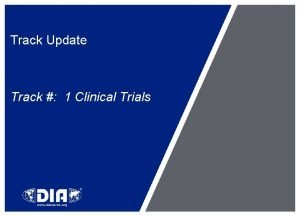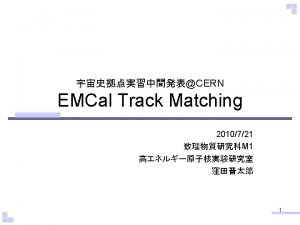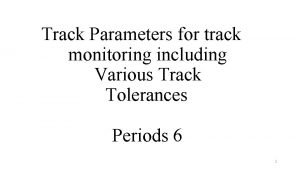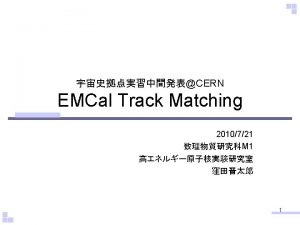College of Fine Arts NonTenure Track Faculty Promotion





























- Slides: 29

College of Fine Arts Non-Tenure Track Faculty Promotion

Outline 1. 2. 3. 4. 5. 6. 7. Promotion Criteria Areas of Contribution Example Evaluation Criteria Promotion Timeline Promotion Case (“Dossier”) File Contents Promotion Strategies Q&A

Promotion Criteria Non-Tenure Track Title Series Promotion to Associate Professor of Practice/Instruction and Senior Lecturer Evidence of excellence in teaching Evidence of significant accomplishment in at least one of the other areas of contribution consistent with the terms of employment (e. g. service, research, advising, or honors). Promotion to Professor of Practice/Instruction and Distinguished Senior Lecturer Evidence of sustained record of significant teaching accomplishment. Evidence of impactful contributions and demonstrated excellence (e. g. leadership) in at least one of the other areas of contribution consistent with the terms of employment.

Possible Areas of Contribution Regardless of the areas of contribution under review, a record of significant contribution, accomplishment and trajectory in the areas must be clearly demonstrated. Teaching at undergraduate and/or graduate levels (required) Research, Creative Activities, and other scholarly effort. Academic advising, counseling, and other student services Administrative and committee service to the department college, and university, and professional public service to the nation, state, and society Other evidence of merit or recognition, such as fellowships, grants, and special honors

What kinds of evaluation criteria are used for Teaching? Quantity and Quality of Teaching Student Assessment (CIS results and written comments) Peer Assessment (Peer observations) Evidence of innovation in teaching methods Evidence of continual revision and improvement of courses and curriculum Evidence of professional development and engagement with the field Teaching portfolio Student mentorship Student placement outcomes post-graduation

What kinds of evaluation criteria are used for Service? Committee and UT Service: Department, College, University Professional Service to your Field: Local, National, International Productive engagement with academic community of the department/school Collegiality Leadership Extracurricular engagement with students or student groups

What kinds of evaluation criteria are used for Research/Creative Work? Depends on the field Examples (may not apply in all cases): Selection by peer review or similar Reputation of the performance/exhibition venue or press or fellowship Critical review, citations, etc. Reputation of collaborators, directors, curators, etc. Quantity Quality

How does the evaluation process work? Evaluation by students (e. g. CIS) If research is one of the areas, then Evaluation by experts from your field Evaluation by peers at UT Austin Annual reviews Peer teaching observations Internal Referees Promotion process itself involves independent review by department EC/BC, then department chair, then college P&T committee, then dean, then central administration The president makes the final decision

Standard Promotion Timeline Recommendations for promotion of non-tenure track faculty may be considered in the 6 th year or later of an individual’s service in current rank. Cumulative service in rank may be either full time or part time. There is no “up-or-out” review for NTT faculty members. Outcomes: promotion in rank or continued appointment at current rank. Annual reviews should capture key elements of case each year. T&D has started doing a third year review for NTT

Atypical promotion schedules Early promotion, in consultation with Chair/Director and Budget Council/Executive Committee Bottom line: when your materials demonstrate teaching excellence and significant contribution in one other area sufficiently, you should go up for promotion.

Abbreviated Components of a promotion dossier When you assemble your tenure dossier, follow the provost office’s P&T guidelines, not the below list. Dean Statement(s) Chair Statement(s), EC/BC statements CV List of all publications and scholarly/creative works (if research is an area) Teaching materials teaching statement, list of courses taught, CIS results (6 years), peer teaching observations (at least 3), list of graduate students and postdoctoral fellows, teaching portfolio Research materials (if research is an area) research statement, list of five most significant works, copies or documentation of all scholarly/creative works Service, Advising, and Honors and Awards materials (optional and depending on if service, advising, and honors are an area) Internal/External Evaluation Letters (4) (if research is an area then at least 2 are external) Supplemental Materials

Developing a promotion strategy Seek out sensible mentoring and advocacy. Ideally from a faculty member familiar with department standards (i. e. has served on the budget council) and the standards of your particular field of expertise. With mentor, determine which secondary area you should concentrate on to build a successful case, and what benchmarks you should meet in that area. With mentor, decide when your promotion file is ready to go up for review.

Developing a promotion strategy, continued Be proactive. Request annual feedback on your progress toward a successful promotion file Ask your department chair or a member of the budget council to bring up during your merit review that you are pursuing promotion in NTT rank and that you would like specific feedback to that end. Begin to build a promotion case as soon as possible – accumulate relevant information and documents as they become available. Request peer teaching observations These are best conducted at regular intervals rather than being crowded into the several weeks or few months prior to a review. The ideal would be one peer teaching observation report from each of the three years preceding the year the promotion is

Developing a promotion strategy, continued Enhance your teaching profile Seek out new teaching responsibilities, diversify course offerings, pioneer innovations in teaching methods, revise curriculum and syllabi regularly, use new technology in your teaching field. Review CIS scores every semester. Regularly revise courses to improve CIS and student outcomes. Offer independent studies. Offer signature courses, where appropriate. Increase student demand/enrollment in your courses by developing popular courses and teaching them well. Maintain a Teaching Portfolio that documents your curricular

Developing a promotion strategy, continued Enhance your service profile Seek out and accept appointment to department, college, and university committees, including serving as committee chair or in a leadership role (program head, etc. ) Participate in national or regional scholarly or professional organizations and conferences in your field. Enhance your advising profile Stay in touch with your students, past and present. Document any jobs you help them get after graduation. Develop a list of students you mentored directly and what jobs, internships, graduate programs they are now doing (or that you helped them get) after graduation. Mentor your students successfully to professional or academic outcomes and document it.

Promotion Timetable, Part II 1. Right away, develop a promotion strategy. 2. Ask for and get at least one peer teaching observation during each of the three years preceding your promotion review. 3. February/March before your promotion review, request review of your promotion file in writing to the department chair and budget council. 4. May before your promotion review, with department chair develop list of external reviewers 5. By August 15, finish assembling promotion dossier. 6. Fall semester, promotion review is conducted. 7. February 15, decisions are announced.

Where to go with questions/concerns Your chair/director: Susan Rather, Chair, Department of Art and Art History Robert Ramirez, Chair, Department of Theatre and Dance Mary Ellen Poole, Director, Butler School of Music Kate Canales, Chair, Design Michael Baker, Department of Arts and Entertainment Technologies Your faculty affairs coordinator: Michelle Harper, Department of Art and Art History Cassie Gholston, Department of Theatre and Dance Andrea Melendez, Butler School of Music Cameron Weed, School of Design and Creative Tehcnologies Douglas Dempster, Dean Tim Creswick, Executive Assistant

Questions?

Reference material for faculty evaluation, promotion and tenure College of Fine Arts Faculty Promotion and Tenure website resources: http: //sites. utexas. edu/cofafaculty/faculty-review/ President’s Letter & Guidelines on Faculty Promotion & Tenure: https: //provost. utexas. edu/faculty-affairs/evaluation Recommendations regarding faculty promotion (HOP 2 -2160): https: //policies. utexas. edu/policies/recommendations-regardingfaculty-compensation-faculty-promotion-tenure-renewalappointment Faculty Leaves (HOP 2 -2210): https: //policies. utexas. edu/policies/faculty-leaves-and-specialacademic-assignments

Reference material for faculty evaluation, promotion and tenure, continued Academic Titles and Tenure (HOP 2 -2010): https: //policies. utexas. edu/policies/academic-titles-and-tenure Faculty Sick & Parental Leave Policies: http: //sites. utexas. edu/cofafaculty/faculty-policies/ Family Friendly Policies and Resources: http: //sites. utexas. edu/cofafaculty/faculty-policies/ and https: //provost. utexas. edu/faculty-affairs/life-and-work Office of the Provost resources: https: //provost. utexas. edu/faculty-affairs

Teaching Support Faculty Innovation Center https: //facultyinnovate. utexas. edu/ Review your CIS results each semester https: //utdirect. utexas. edu/ctl/ecis/results/mycis. WB X COFA Teaching Load and Course Enrollment policy http: //sites. utexas. edu/cofafaculty/facultypolicies/teaching-load-and-course-enrollment/

Research Support COFA Faculty Development & Travel Funds – inquire with Chair/Director Dean’s Fellow/Ducloux Fellowship – inquire with Chair/Director http: //sites. utexas. edu/cofafaculty/facultypolicies/faculty-research-leaves/ Fine Arts Faculty Creative Research Grants/Summer Stipends – application cycle begins in early spring. http: //sites. utexas. edu/cofafaculty/research/fine-arts-

Research Support, continued Subvention Grants – Office of the Vice President for Research https: //research. utexas. edu/findfunding/awards-fellowships-grants/subventiongrants-programs/ Special research grants – Office of the Vice President for Research https: //research. utexas. edu/ Big XII Faculty Fellowship Program – Office of Graduate Studies https: //gradschool. utexas. edu/faculty/big-xii-facultyfellowships

Components of a promotion file, IV. Research/Scholarship/Creativity continued– if applicable • Budget council statement • Copies of scholarly works produced in rank, in a separate folder • List of five most significant works (while in rank) One set of the five most significant works, in a separate folder • Candidate’s research statement V. Advising section – if applicable • Budget Council Statement • Candidate’s advising statement (optional) VI. Service section – if applicable • Budget Council Statement • Candidate’s service statement (optional)

Components of a promotion file I. Recommendations (required) II. CV and Other Information (required) • Dean’s Assessment Letter • Chair or Director’s Assessment Letter • CV • List of publications and scholarly/creative works III. Teaching (required) • Budget council statement • Candidate’s teaching statement • Candidates instructional activities (aka Course Instructor Survey results) – previous three years of coursework • Peer Classroom Observation Reports (include all conducted in rank – minimum of three total for NTT promotion cases) • Report of committee affiliations for masters and doctoral theses – if applicable • List of postdoctoral fellows supervised – if applicable • Original CIS forms and written comments for the last six years with summary sheet as cover page for each course (in a separate

Components of a promotion file, VII. Honors section – ifcontinued applicable • Budget council statement • Candidate’s statement on honors (optional) VIII. Letters Section – four internal or external assessment letters (required) IX. Supplemental Materials – discretionary

Levels of review Budget council (or executive committee) sub-committee reports to the budget council. Budget council (or executive committee) deliberates, votes and makes recommendation to Chair/Director deliberates and makes recommendation to Dean. College Promotion and Tenure Advisory Committee deliberates and makes recommendation to Dean reports in cover letter and advocates to President’s

Institutional (President’s) Committee President Provost Dean of Graduate Studies Dean of Undergraduate Studies Vice President for Research

Components of a promotion file For resources and general guidelines, see: http: //sites. utexas. edu/cofafaculty/faculty-review/ For Joint Appointments – a separate dossier is assembled in each department
 Nitade chula
Nitade chula Hegel three forms of art
Hegel three forms of art Expressionism video
Expressionism video Fine arts
Fine arts Fine arts
Fine arts Marshall middle school houston tx
Marshall middle school houston tx Foothills fine arts academy
Foothills fine arts academy Academy of fine arts vienna
Academy of fine arts vienna Academic tracks
Academic tracks Creative arts grade 8 exam papers term 2
Creative arts grade 8 exam papers term 2 University of central florida health care administration
University of central florida health care administration College of charleston faculty salaries
College of charleston faculty salaries St ann's engineering college chirala faculty
St ann's engineering college chirala faculty Dorothy f schmidt college of arts and letters
Dorothy f schmidt college of arts and letters Lahc sis
Lahc sis Ves college of arts science and commerce
Ves college of arts science and commerce Retailer and wholesaler difference
Retailer and wholesaler difference Bon secours arts and science college
Bon secours arts and science college Uf clas advisors
Uf clas advisors Queens college in thanjavur
Queens college in thanjavur Ilfracombe arts college
Ilfracombe arts college Early college high school at midland college
Early college high school at midland college Asd college college readiness program
Asd college college readiness program Wills little flower school
Wills little flower school Hms office of faculty affairs
Hms office of faculty affairs Faculty of organizational sciences
Faculty of organizational sciences The faculty
The faculty University of bridgeport engineering
University of bridgeport engineering Short story for memory test
Short story for memory test Uab oncology faculty
Uab oncology faculty


